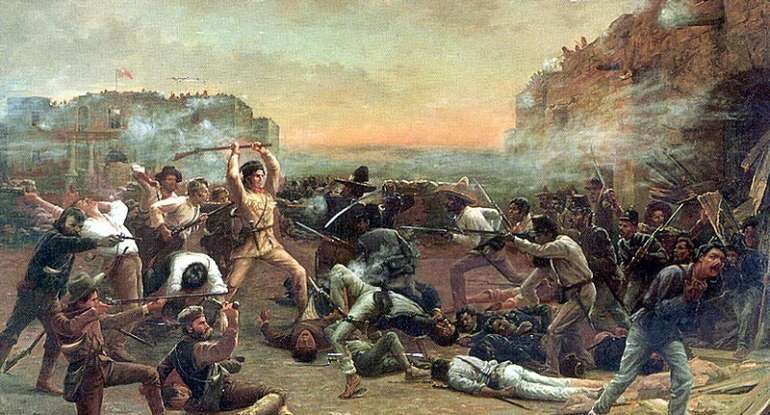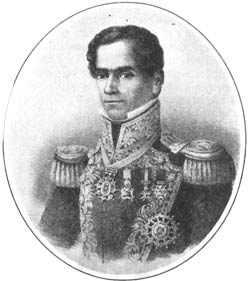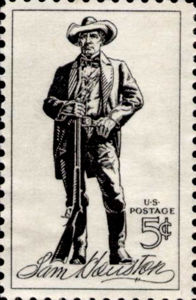…and if We Didn’t Have Texas, Would We Have the United States?

“The Fall of the Alamo” by Robert Jenkins Onderdonk (via Wikipedia)
If you know any Texans on Facebook, you’ve probably seen them posting about the Texas Revolution, Texas Independence Day, and a certain iconic old church lately. You’ll see posts about battles, “Come and Take It,” and names like William Barret Travis, Jim Bowie, and David Crockett. These are Texas’ “high holy days,” when we remember the Alamo and look forward to San Jacinto in late April. The two battles are crescendos of the Texas Revolution.
Texans never really get tired of bragging about our history, even the grim parts. But what if Texas had lost its revolution?
You’ll see revisionist historians posit that the Texas Revolution was either of little consequence or that it was a racial war between racist Anglos from the United States and Mexicans. This puts an identity politics and Marxist spin on what was a pre-Marxist revolution, and ignores what was actually happening in the world at the time. Several Texas revolutionary leaders were men like Juan Seguin and Lorenzo de Zavala. The latter was a prominent doctor, publisher, and Mexican diplomat before joining Texas’ rebellion.
The Texas Revolution was a product of its time. Mexico was divided over which form of government it should take after winning independence from Spain. Federalists wanted power shared among the states and a weaker federal government. Centralists sought a much stronger central government and little or no power in the hands of state and local governments. Both were working from existing models.
By the time Napoleon crowned himself emperor of France in 1804, the United States had already enjoyed peaceful transfers of power. President George Washington served two terms and then John Adams succeeded him. And then Thomas Jefferson succeeded Adams.
Napoleon set about invading his neighbors and installing cronies and family members to replace the kings and queens he displaced — making his brother Joseph king of Spain, for instance. Napoleon centralized political power in his own hands, by whatever means he thought necessary. Force created legitimacy, not the consent of the governed. The United States and France underwent republican revolutions and took very different courses in the early 19th century. They were allies, but they were not much alike. Both revolutions rippled across the world.
Texas in this period was first part of Spain, and then part of Mexico when it won independence from Spain in 1821. While Mexico rebelled against Spain, it carried the legacy of its mother country in ways similar to how the United States carried English political thought and traditions. Centralism was arguably Mexico’s more obvious path as a legacy from Spain and its French influence.

Generalisimo Antonio Lopez de Santa Anna
War hero Antonio Lopez de Santa Anna won the Mexican presidency in 1833. Before his election he had cast himself as a federalist and Anglo Texas colonists from the United States saw him as an ally. But soon after, Santa Anna became a centralist and ditched the federalist Constitution of 1824. The dictator even called himself the “Napoleon of the West.”
This would never sit well with any American who had emigrated to Texas. They were literally the children and grandchildren of the American Revolution. When he joined the Texas rebellion, Crockett swore to uphold only a “republican” form of government.
When 189 Anglos and Tejanos hunkered down in the Alamo, a whole lot more than the frontier fort was at stake. The Texas Revolution can be understood as the clash of great revolutions — the American Revolution and its federalist republican ideals, versus the French Revolution and its centralist strongman form. Two revolutions fought it out in Texas.
History says the Alamo fell, but Sam Houston — the Jacksonian whose father had fought in the American Revolution — defeated dictator Santa Anna about six weeks later, and Texas became a republic and later a state.
Texas’ fate was far from certain in 1836. Santa Anna was an experienced military leader, he had a larger army, and he was in command in the field in Texas. He was dealing with rebellions in nearly a dozen states and wanted to defeat Texas to make an example of it. He declared the revolutionaries “pirates” and pledged to kill them all. He made good on that pledge at the Alamo and Goliad, killing about 600 rebels in the course of a few weeks. Many of the rest were on the run.
 History turned mightily when Sam Houston shocked Santa Anna at San Jacinto. In the following decades, Texas established itself as an economic power, providing much of America’s cotton and beef in the 19th century and now powering America with its plentiful oil and natural gas. If Texas was its own country, it would be the world’s third-largest energy provider.
History turned mightily when Sam Houston shocked Santa Anna at San Jacinto. In the following decades, Texas established itself as an economic power, providing much of America’s cotton and beef in the 19th century and now powering America with its plentiful oil and natural gas. If Texas was its own country, it would be the world’s third-largest energy provider.
But what if Santa Anna had defeated Sam Houston and Texas is never free from him?
At the time, Texas stretched up to what is now Wyoming. So America stops growing west. Imagine a large hostile dictatorship living right next to the United States, which is only half its current size and dependent on that dictatorship for its fuel, its cotton for textiles, and much of its beef. Imagine that dictatorship bossing the little United States around because of its vast economic might in comparison.
Who knows how the Civil War plays out? The 20th and 21st centuries look a whole lot different with Texas’ vast oil and natural gas in the hands of a petro-dictatorship.
The Nazis win. The Communists win. Because America is weaker without Texas.
The federalist vs. centralist argument is still going on. It’s what drives most issues in our politics. Do we want the states or the federal government to do things (or neither)? Texas sides with the federalists, which is why today’s centralists — the socialists in the Democratic Party — hate it as much now as Santa Anna hated it in 1836. Texas stands in their way.
Well, that and we have the best BBQ, the best tacos, the best music… you get the idea.
Written by Bryan Preston for PJ Media ~ March 5, 2019
